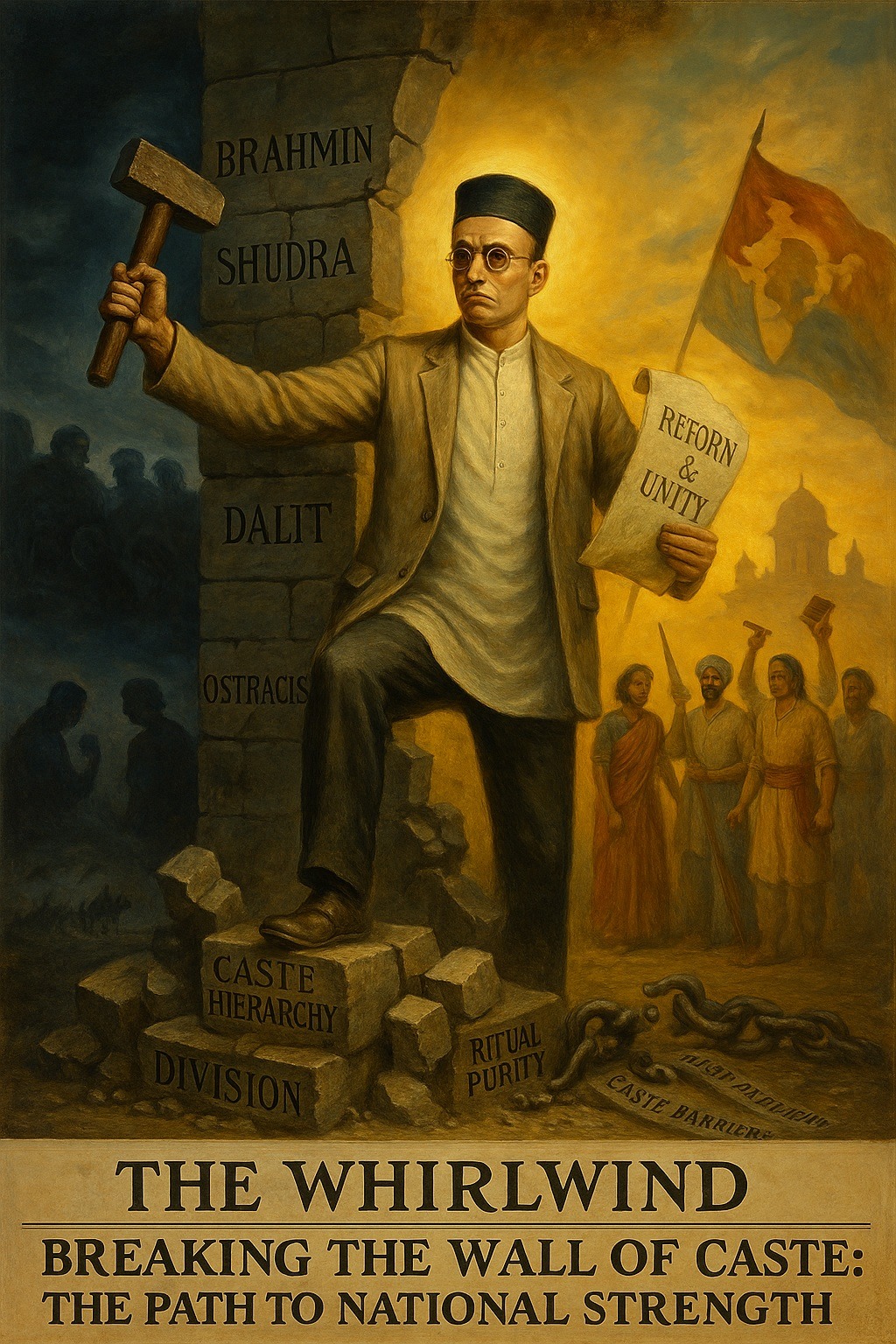The caste system has long been a defining yet contentious element of Hindu society. Vinayak Damodar (Veer) Savarkar, a fierce nationalist and reformist, saw this system not just as a social hierarchy but as a significant barrier to Hindu unity and nation-building. His critique of caste-based social ostracism stemmed from his conviction that it weakened Hindu society and made it vulnerable to external threats, particularly from Islamic and Christian forces.
The Caste System as a Hindrance to Nation-Building
Savarkar argued that Hindus mistakenly believed they were preserving the purity of their caste and religion by strictly enforcing caste boundaries. This illusion, he claimed, intensified during the Muslim invasions, as Hindus became more rigid in their caste practices in an attempt to resist external influences. However, rather than strengthening Hindu society, this rigidity fragmented it, making it susceptible to exploitation by hostile religious communities.
One of Savarkar’s most significant observations was that opponents of Hinduism deliberately exploited its caste excesses. Social ostracism, a punishment for violating caste norms, was a prime example. According to Savarkar, foreign religious groups encouraged caste violations through forced “physical conversion,” leading to mass conversions and a weakened Hindu community. Initially intended as a disciplinary tool, social ostracism ultimately worked against Hindus by driving them into the arms of other religious groups.
The Injustice of Caste Punishments
Savarkar was particularly critical of the indiscriminate application of caste punishments. He pointed out that Hindus imposed severe penalties for even minor offenses against caste laws, regardless of whether the violation was voluntary or involuntary. The harshest punishment—permanent expulsion from one’s caste—was akin to excommunication in Christian traditions. Those who were outcasted lost all social connections, including family ties, and were denied religious and social services.
This not only affected the individual but also their descendants, who were burdened with socio-religious disadvantages. Other castes, fearing similar ostracization, avoided interacting with them, reinforcing their exclusion. Savarkar saw this practice as a direct threat to Hindu unity, as it:
- Weakened the Hindu community by reducing its numbers and fostering internal divisions.
- Drove outcast individuals towards conversion to Islam or Christianity, where they often became staunch opponents of their former faith.
The Moplah Rebellion and the Need for Reconversion
Savarkar cited the Moplah Rebellion in Malabar (1921) as a prime example of forced conversions exploiting caste exclusions. He argued that these converts were unfairly excommunicated and that reconversion was both necessary and justified. Hindu orthodoxy, he believed, needed to abandon the rigidity of caste laws that made such forced conversions permanent.
The Seven Indigenous Fetters
During his imprisonment, Savarkar identified seven self-imposed constraints that crippled Hindu society. Unlike foreign-imposed restrictions, these “seven indigenous fetters” were voluntarily accepted by Hindus in an extreme effort to protect their religion. Among them were:
- The ban on overseas travel
- Social ostracism for caste violations
- The prohibition of reconversion
He believed that these prohibitions were exacerbated by foreign rule, particularly under Muslim influence, which reinforced Hindu fears and led to the distortion of original religious texts (Smritis). According to Savarkar, Hindu lawmakers, under duress from foreign invasions, introduced new doctrines and prohibitions that were mistakenly given the same authority as the original scriptures.
Caste as a Double-Edged Sword
Savarkar acknowledged that the caste system originally provided stability and social order. It facilitated Hindu resilience under difficult historical circumstances. However, he warned against overlooking its later harmful effects. He argued that while the system initially preserved racial and cultural purity, it eventually became an obstacle to national unity and progress.
Final Thoughts: Reforming Hindu Society for National Strength
Savarkar’s critique of social ostracism and the rigid caste system was not just an academic argument; it was a call to action. He urged Hindus to recognize that many of their self-imposed restrictions were detrimental to their own strength as a community. His advocacy for reconversion and caste reform was aimed at fostering unity and resilience among Hindus.
By identifying and addressing these internal weaknesses, Savarkar sought to build a stronger, united Hindu nation—one that could resist external threats and thrive in the modern world.
💭 What do you think? Why did Savarkar see caste-based social ostracism as a direct threat to Hindu unity? How does his critique of caste compare with other reformers you know of? Do you think Savarkar’s reference to the Moplah Rebellion is a strong example of how caste rigidity was exploited? Why or why not? Do you think caste practices still hinder national unity in modern India? Can reconversion or social reintegration, as Savarkar proposed, still play a role today? Savarkar saw caste as both a source of stability and a source of weakness. Do you agree with this double-edged perspective?
👉 Share your thoughts in the comments below!
Sources:
GODBOLE, Vasudev Shankar. 2004. Rationalism of Veer Savarkar. Itihas Patrika Prashan: Thane/Mumbai.
KEER, Dhananjay. 1988. Veer Savarkar. Third Edition. (Second Edition: 1966). Popular Prakashan: Bombay (Mumbai).
SAMPATH, Vikram. 2019. Savarkar (Part 1). Echoes from a forgotten past. 1883-1924. Penguin Random House India: Gurgaon.
VAIDYA, Prem. 1997. Memorable Documentary on Revolutionary Freedom Fighter Veer Savarkar. Veer Savarkar Prakashan: Mumbai.
WOLF, Siegfried O. 2010. Savarkar’s Strategic Agnosticism. A compilation of his political and economic worldview, in Heidelberg Papers in South Asian Comparative Politics (HPSACP), No. 51, Heidelberg University, Germany.
WOLF, Siegfried O. 2009. Vinayak Damodar Savarkar und sein Hindutva-Konzept. Die Konstruktion einer kollektiven Identität in Indien [“Vinayak Damodar Savarkar and his concept of Hindutva: The construction of a collective identity in India.”]. Online Dissertation: Heidelberg University: Heidelberg.


Leave a Reply